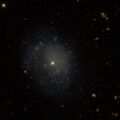Astronomy:NGC 4707
From HandWiki
Short description: Galaxy in constellation Canes Venatici
| NGC 4707 | |
|---|---|
| File:NGC 4707 - HST - Potw1651a.tif NGC 4707, imaged by the Hubble Space Telescope | |
| Observation data (J2000 epoch) | |
| Constellation | Canes Venatici |
| Right ascension | 12h 48m 21.666s[1] |
| Declination | +51° 09′ 53.81″[1] |
| Redshift | 0.001561[2] |
| Helio radial velocity | 468 km/s[2] |
| Distance | 22.11 ± 3.64 Mly (6.780 ± 1.116 Mpc)[2] |
| Apparent magnitude (V) | 12.91[2] |
| Apparent magnitude (B) | 15.2[3] |
| Absolute magnitude (V) | -16.23[2] |
| Characteristics | |
| Type | Sm/Im[3] |
| Size | 16,100 ly (4,930 pc)[2] |
| Apparent size (V) | 1.120′ × 1.045′[3] |
| Other designations | |
| UGC 7971, MCG+09-21-050, PGC 43255, DDO 150[3] | |
NGC 4707 is an irregular galaxy in the constellation of Canes Venatici. It was discovered by John Herschel on 5 June 1834,[4] and was described by John Louis Emil Dreyer, the compiler of the New General Catalogue, as a "small, stellar" galaxy.[5]
NGC 4707 has a morphological type of Sm or Im, meaning that it is mostly irregular or has very weak spiral arms.[3] The galaxy was imaged by the Hubble Space Telescope in 2016. The image showed the galaxy had little to no signs of a central bulge or any prominent structures (typical of Magellanic-type spirals). However, the telescope could resolve many stars, as well as several turquoise-colored star forming regions.[6]
Gallery
NGC 4707 by GALEX
References
- ↑ 1.0 1.1 Adelman-McCarthy, J. K. (2009). "VizieR Online Data Catalog: The SDSS Photometric Catalog, Release 7". VizieR On-line Data Catalog. Bibcode: 2009yCat.2294....0A.
- ↑ 2.0 2.1 2.2 2.3 2.4 2.5 "NED results for object NGC 4707". National Aeronautics and Space Administration / Infrared Processing and Analysis Center. http://nedwww.ipac.caltech.edu/cgi-bin/nph-objsearch?objname=NGC+4707&extend=no&out_csys=Equatorial&out_equinox=J2000.0&obj_sort=RA+or+Longitude&of=pre_text&zv_breaker=30000.0&list_limit=5&img_stamp=YES.
- ↑ 3.0 3.1 3.2 3.3 3.4 "NGC 4707". SIMBAD. Centre de données astronomiques de Strasbourg. http://simbad.u-strasbg.fr/simbad/sim-basic?Ident=NGC+4707.
- ↑ Seligman, Courtney. "New General Catalogue objects: NGC 4700 - 4749". http://cseligman.com/text/atlas/ngc47.htm#4707.
- ↑ "NGC 4707 - SEDS". http://spider.seds.org/ngc/ngc.cgi?NGC4707.
- ↑ "Astro-pointillism | ESA/Hubble". 2016. https://www.spacetelescope.org/images/potw1651a/.
External links
 |



